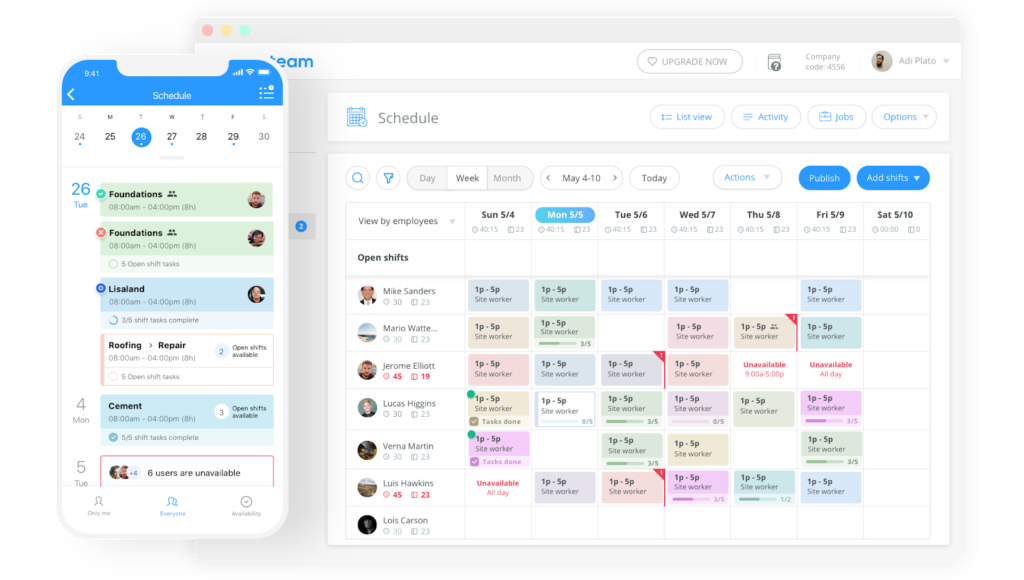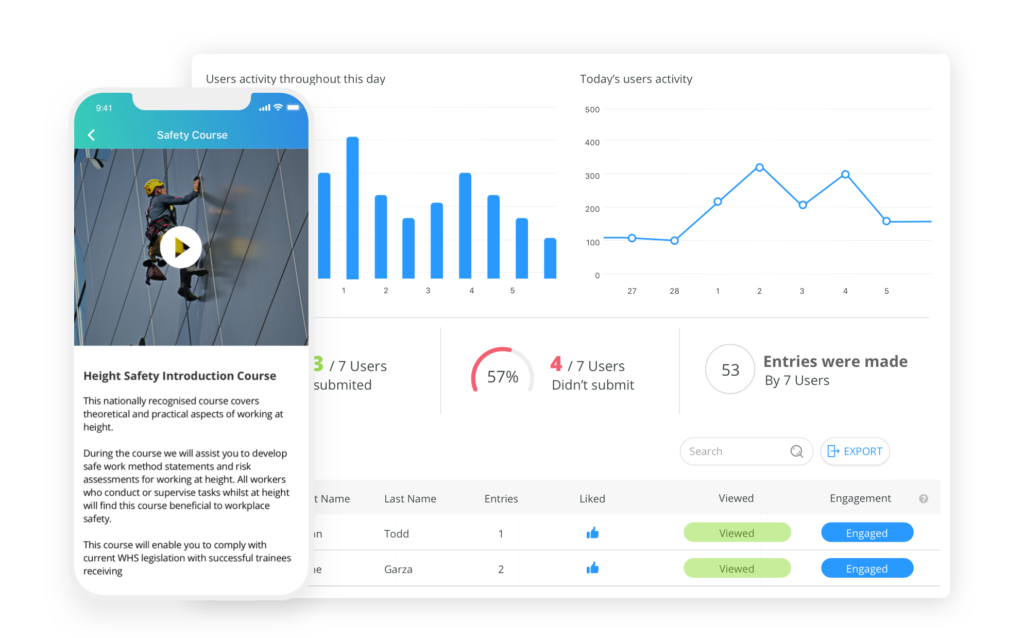Learn how to properly classify your employees and understand the difference between part time and full time employees. Whether you’re a manager or an employee, this guide covers both schedules in full.
As a manager, when you’re looking to hire new staff or are revamping your scheduling needs, there are so many questions running through your mind. Most of which are centered around the difference between part-time and full time employment.
For example, you’re probably asking yourself how many hours is full-time? What is the difference between part-time and full-time? If you think it’s just the hours filled out on their timesheets, think again! There is so much more to it than that.
This guide is set to provide you with all the information that you need to create efficient schedules for your part-time and full-time staff. Whether it’s the basics of understanding the difference between part-time and full-time or answering what is full-time work, we have you covered!
What Is Full Time Employment?
Full-time employment is a classification set by law to define a sensible standard for working hours and after which amount of hours hourly-paid employees are eligible for overtime compensation.
We’re all familiar with the classic 9-5 job—which comes to 40 hours per week—and most consider that full-time work. However, you’ll be surprised to learn that things aren’t as straightforward. Different state and federal bodies have different definitions for full time hours.
What Are Full Time Hours?
Unfortunately, there is no short answer to this question, so bear with me.
The Internal Revenue Service (IRS) and Affordable Care Act (ACA) state that any employee working at least 30 weekly or 130 monthly hours is part of the full time clasification.
The Bureau of Labor Statistics sets the bar for full-time work at least 35 hours a week.
According to the Fair Labor Standards Act (FLSA), employers should determine how many hours they choose to set as part time and full time. However, when doing this, you should ensure it abides by federal and state laws.
The ACA stipulates that it is the employer’s responsibility to use one of the two different IRS-approved measurement methods for determining ACA full-time employees, namely:
- The Look-Back Measurement Method
- The Monthly Measurement Method
The Look-Back Measurement Method typically works best for organizations that have a large amount of part-time employees.
According to this method, employers can monitor and track their employee’s hours of service over a predetermined amount of time to determine if they are full-time under the ACA. This guides employers on when to extend an offer of coverage to employees who are considered full-time under the ACA.
The Look-Back Measurement Method is composed of three phases:
- The measurement period: Over a predetermined amount of time of 3-12 months, the employer measures their employees’ hours of service. The employer can then categorize the employee as either full-time or part-time based on if an employee averaged at least 30 weekly hours.
- The administrative period: For up to 90 days, the employer analyzes the employee hour data to determine which employees have satisfied the requirements and to whom the employer is required to extend offers of coverage.
- The stability period: Over the course of at least 6 months, employees are locked into full- or part-time status. The employer must offer coverage to employees identified as full-time employees during the measurement period.
The Monthly Measurement Method is designed for workforces that have primarily full-time employees. According to this method, the employer can look at each month to ensure the employee has completed at least 130 hours of service per month or 30 hours per week. An employee can therefore fluctuate between full-time and non-full-time as the hours are averaged each month.
The FLSA does not limit the number of hours employees aged 16 and over can work. However, it’s deemed overtime once they reach over 40 hours per week. The overtime pay should not be less than a time and a half.
How Many Hours is Part Time?
There is no clear-cut answer to the question of how many hours is part time. The number of hours an employee has to work to be considered on a part time schedule depends on a number of factors, such as their position, your company policy, and the specific agreement you have with the employee.
As a rough general guide, employees who work between 20 and 29 hours per week are often considered part-time employees.
Connecteam – No.1 Scheduling App
Create the perfect schedule with drag and drop, repeat shifts, approve sick & vacation days, and so much more, all while on the go! Use the AI scheduler to instantly assign open shifts based on employee availability, preferences, and qualifications.

What is the Difference Between Part Time and Full Time?
Weekly Schedule, Including Hours
The first main difference between part time and full time work is the schedule. So, if you’re looking to hire staff for full time work, you are wondering how many hours is full time? Your employee will most likely work a 40 hour week. These employees should receive certain benefits as they will be spending many hours working. The benefits include:
- Health insurance
- Pension plans
- Vacation days
- Sick days
- and more.
Depending on your line of work, this will also reflect how you schedule your employees. For example, if you’re in the retail business, the hours and days look very different from that of an office worker. This is because office hours rarely change. Yes, sometimes those workers might require some overtime. However, in the retail trade, during peak seasons such as Christmas, you may need your current staff to work overtime, or you may need to employ extra help.
When a non-exempt worker works over 40 hours, they begin to receive overtime pay. Overtime is usually time and a half. Check with your state to find out the rules that apply to you.
In case you’re wondering about exempt workers – aka salaried employees – these employees are excluded from FLSA overtime regulations. Rather than getting paid for the number of hours they work, exempt employees are paid for the tasks they perform. These tasks are typically knowledge-based and so difficult to track on an hourly basis.
When comparing the difference between part time vs full time jobs, a part time schedule includes more flexibility that allows the worker to take on other responsibilities outside of work. Often employees are parents or students and opt for this type of work.
When you set out your schedule for the week, an employee working full time will have to work all the hours you set for them. If that’s a 40 hour week, your staff are expected to complete a 40 hour week. Whereas part time employees can work the full 40 hours or less, there is no obligation to work any amount of time.
Connecteam – No.1 Scheduling App
Create the perfect schedule with drag and drop, repeat shifts, approve sick & vacation days, and so much more, all while on the go!
Salary
When it comes to paying your workers, there is a difference between part time vs full time. Your full-time employee will receive a standard salary, so if you set that they will earn $2000 a month, that will be their salary.
For part time employees, their salary reflects the hours worked. If the rate is $10/hour and they worked 40 hours that week, you will pay them $400. Keep in mind that full-time employees can also be paid by the hour. However, they will receive a total sum at the end of the month that doesn’t usually change. The only change could be that you offered a bonus for that month or they completed overtime.
Taxes for Part Time vs Full Time Employees
Whether your employee is part time or full time, it doesn’t matter how many hours is full time, they will be taxed according to the Federal Contributions Insurance Act (FICA). This act is for the tax that is deducted from every paycheck. You need to check with your state to ensure that you are taxing every employee according to the state laws.
Job Security for Part Time vs Full Time Employees
Some workers will be reluctant to take on part time hours because they consider it to be less secure. A lot of employees fear that they won’t be treated the same way as full-time workers. Their trepidation comes from worries about not receiving the same benefits or that they are replaceable. However, this isn’t always the case when it comes to part time hours.
Onboarding for Part time vs full time
Whether you onboard your employees for full time work or part time hours, it won’t matter how many hours is full time, because the onboarding process is the same. This includes:
- Providing manuals
- Handbooks
- Advise your team that there will be a new hire
- Make them feel part of the team

FAQs
What kind of jobs is suitable for part time employment?
Traditionally, retail and hospitality have been the leading industries for part time jobs. This is mainly as such jobs often require flexible time schedules to fit changes in demand. Nowadays, the term “part time” can pop up in pretty much any job description as part time jobs are offered across more and more professions to give employees and employers more flexibility.
Can a part time employee become a full time staff member?
Yes, a part time employee may indeed end up working full time hours for an extended period or switch to a full time position. To ensure that you comply with IRS and ERISA regulations and offer consistent benefits to your staff, have a company policy in place that describes when a part time employee becomes full time.
What benefits are part time employees entitled to?
The FLSA doesn’t state whether part time employees are eligible for the same benefits as full time employees. Part time workers are generally entitled to a minimum wage. They should also be given meal and rest breaks relative to the length of their shift. In many cases it is up to the employer to determine whether they will offer additional benefits.
What is Full-Time Equivalent (FTE) and how do I calculate it?
Full-Time Equivalent (FTE) represents the theoretical number of full-time employees needed to complete all the work hours at your company. To calculate it, divide the total weekly hours worked by all employees by your standard full-time hours. For example, if your company defines 40 hours as full-time and your employees collectively work 120 hours per week, your FTE would be 120 ÷ 40 = 3.0. This means your workforce represents the equivalent of 3 full-time employees, regardless of how many actual people you employ. FTE calculations are essential for ACA compliance (companies with 50+ FTEs must provide health benefits) and for workforce planning. You can also calculate individual employee FTEs by dividing their hours by standard full-time hours (a 20-hour employee would be 0.5 FTE with a 40-hour standard).
You can read more about what is full-time equivalent (FTE) and how do I calculate it here
The Bottom Line on Part Time vs Full Time Employees
Whether your business requires part-time hours or full-time employees, make sure you’ve checked with your state for all the rules and regulations. Now you have all the pros and cons and you understand more about what each type of job involves, you can make an educated choice. If you add technology to your business, you can become more productive, more effective, and in turn, keep your employees for the long haul.
Join thousands of business who are benefiting from Connecteam!
Create schedules in minutes using drag and drop, repeat schedules, approve sick & vacation days, and so much more!



